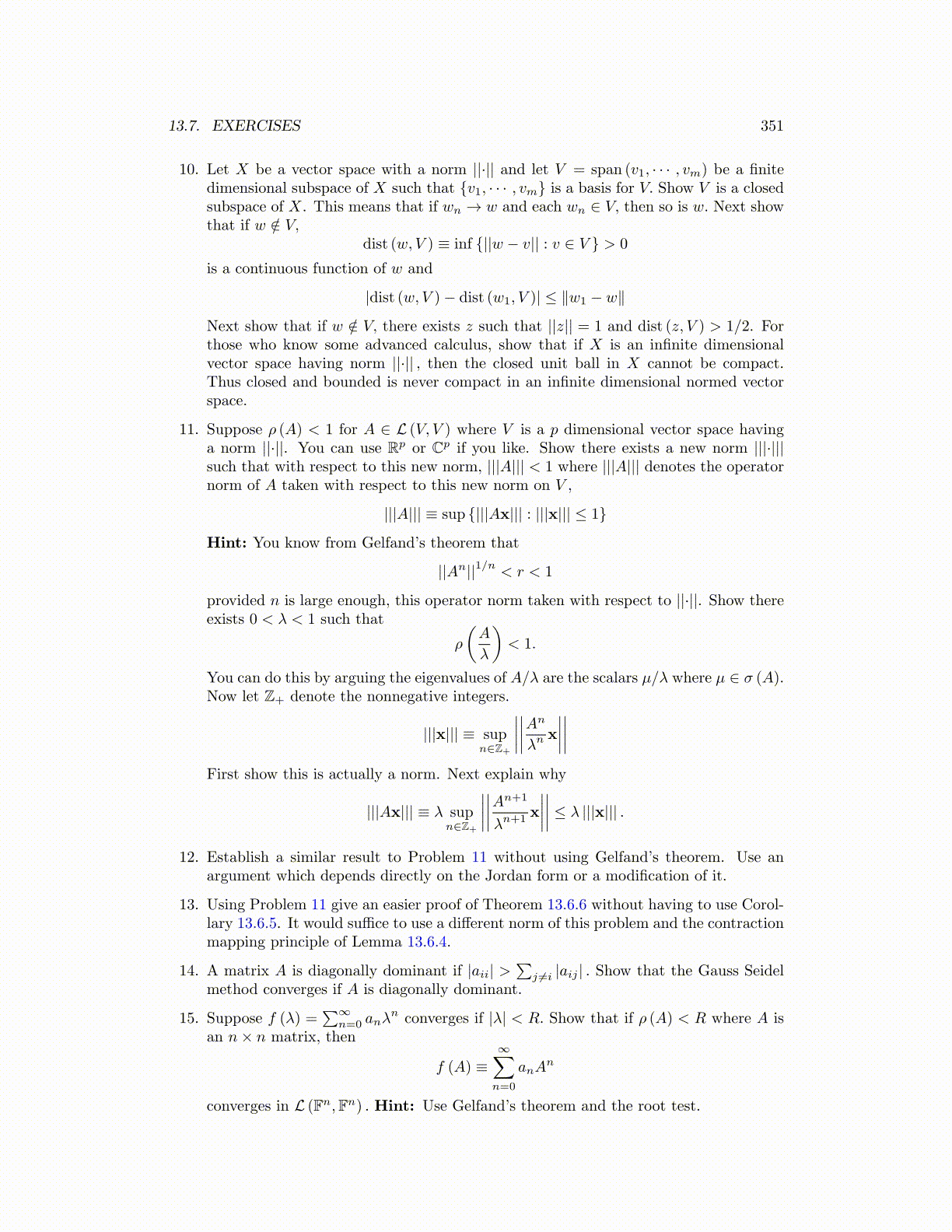
13.7. EXERCISES 351
10. Let X be a vector space with a norm ||·|| and let V = span (v1, · · · , vm) be a finitedimensional subspace of X such that {v1, · · · , vm} is a basis for V. Show V is a closedsubspace of X. This means that if wn → w and each wn ∈ V, then so is w. Next showthat if w /∈ V,
dist (w, V ) ≡ inf {||w − v|| : v ∈ V } > 0
is a continuous function of w and
|dist (w, V )− dist (w1, V )| ≤ ∥w1 − w∥
Next show that if w /∈ V, there exists z such that ||z|| = 1 and dist (z, V ) > 1/2. Forthose who know some advanced calculus, show that if X is an infinite dimensionalvector space having norm ||·|| , then the closed unit ball in X cannot be compact.Thus closed and bounded is never compact in an infinite dimensional normed vectorspace.
11. Suppose ρ (A) < 1 for A ∈ L (V, V ) where V is a p dimensional vector space havinga norm ||·||. You can use Rp or Cp if you like. Show there exists a new norm |||·|||such that with respect to this new norm, |||A||| < 1 where |||A||| denotes the operatornorm of A taken with respect to this new norm on V ,
|||A||| ≡ sup {|||Ax||| : |||x||| ≤ 1}
Hint: You know from Gelfand’s theorem that
||An||1/n < r < 1
provided n is large enough, this operator norm taken with respect to ||·||. Show thereexists 0 < λ < 1 such that
ρ
(A
λ
)< 1.
You can do this by arguing the eigenvalues of A/λ are the scalars µ/λ where µ ∈ σ (A).Now let Z+ denote the nonnegative integers.
|||x||| ≡ supn∈Z+
∣∣∣∣∣∣∣∣An
λnx
∣∣∣∣∣∣∣∣First show this is actually a norm. Next explain why
|||Ax||| ≡ λ supn∈Z+
∣∣∣∣∣∣∣∣An+1
λn+1 x
∣∣∣∣∣∣∣∣ ≤ λ |||x||| .
12. Establish a similar result to Problem 11 without using Gelfand’s theorem. Use anargument which depends directly on the Jordan form or a modification of it.
13. Using Problem 11 give an easier proof of Theorem 13.6.6 without having to use Corol-lary 13.6.5. It would suffice to use a different norm of this problem and the contractionmapping principle of Lemma 13.6.4.
14. A matrix A is diagonally dominant if |aii| >∑
j ̸=i |aij | . Show that the Gauss Seidelmethod converges if A is diagonally dominant.
15. Suppose f (λ) =∑∞
n=0 anλn converges if |λ| < R. Show that if ρ (A) < R where A is
an n× n matrix, then
f (A) ≡∞∑
n=0
anAn
converges in L (Fn,Fn) . Hint: Use Gelfand’s theorem and the root test.